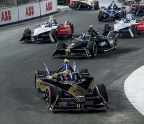Hard and fast

‘On-car software in Formula E is what aerodynamics is to Formula 1, it’s where you can find a competitive advantage’
Juan Pablo Ramirez, head of simulation at Mahindra Formula E
In the mid 2000s, some Formula 1 teams were testing up to 250 days per year. Today, they are restricted to just eight on track days: three days pre-season, three in-season and a two-day tyre test. It’s no surprise, then, that teams turned their attention to simulators which then resulted in a huge surge of development in motion platforms, vehicle models and graphics technology. It is now sim sessions that overwhelm a race engineer’s calendar.
Meanwhile, the continued adoption of hybrid and electric powertrains in motorsport has forced teams to focus their development on energy management and control strategies. This involves complex software running on devices such as ECUs (Electronic Control Unit) which can be difficult to model accurately. To enable teams to test these software strategies, simulators have had to take another technological step. Modern Formula 1 and Formula E driver in the loop (DIL) simulators can now fully integrate hardware in the loop (HIL), which allows teams to test the real ECU hardware and associated control systems from the car in a simulated environment, with the driver.
‘On-car software in Formula E is what aerodynamics is to Formula 1, it’s where you can make your competitive advantage,’ says Juan Pablo Ramirez, head of simulation at Mahindra Formula E team. ‘Hardware in the loop allows you to run many automated tests
You’re reading a preview, subscribe to read more.
Start your free 30 days





